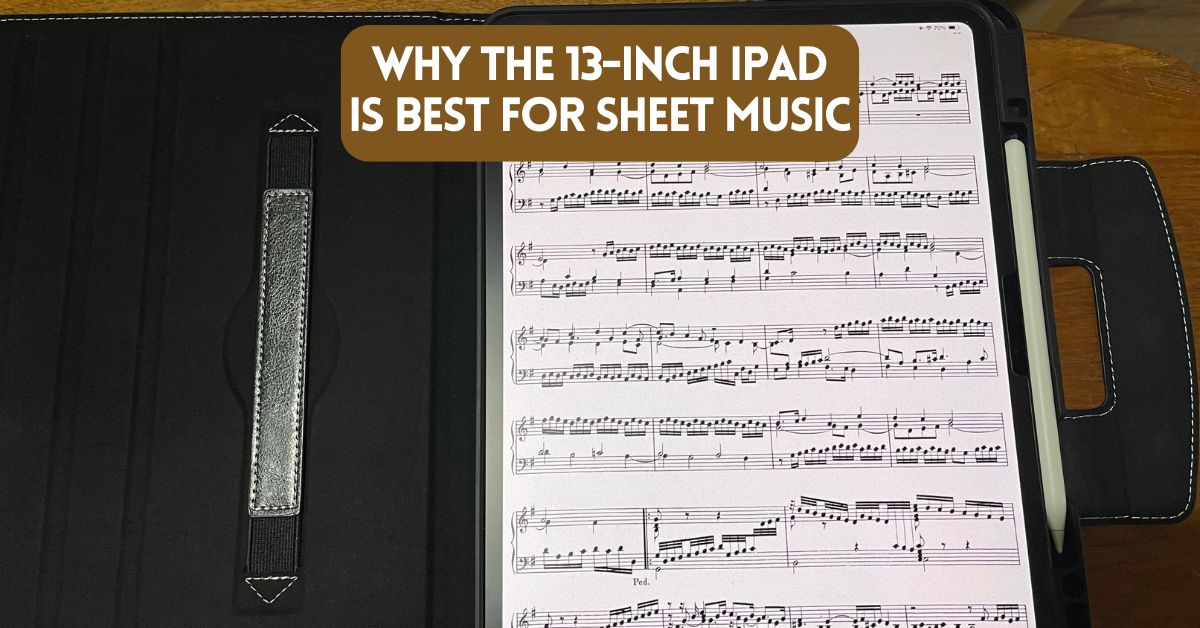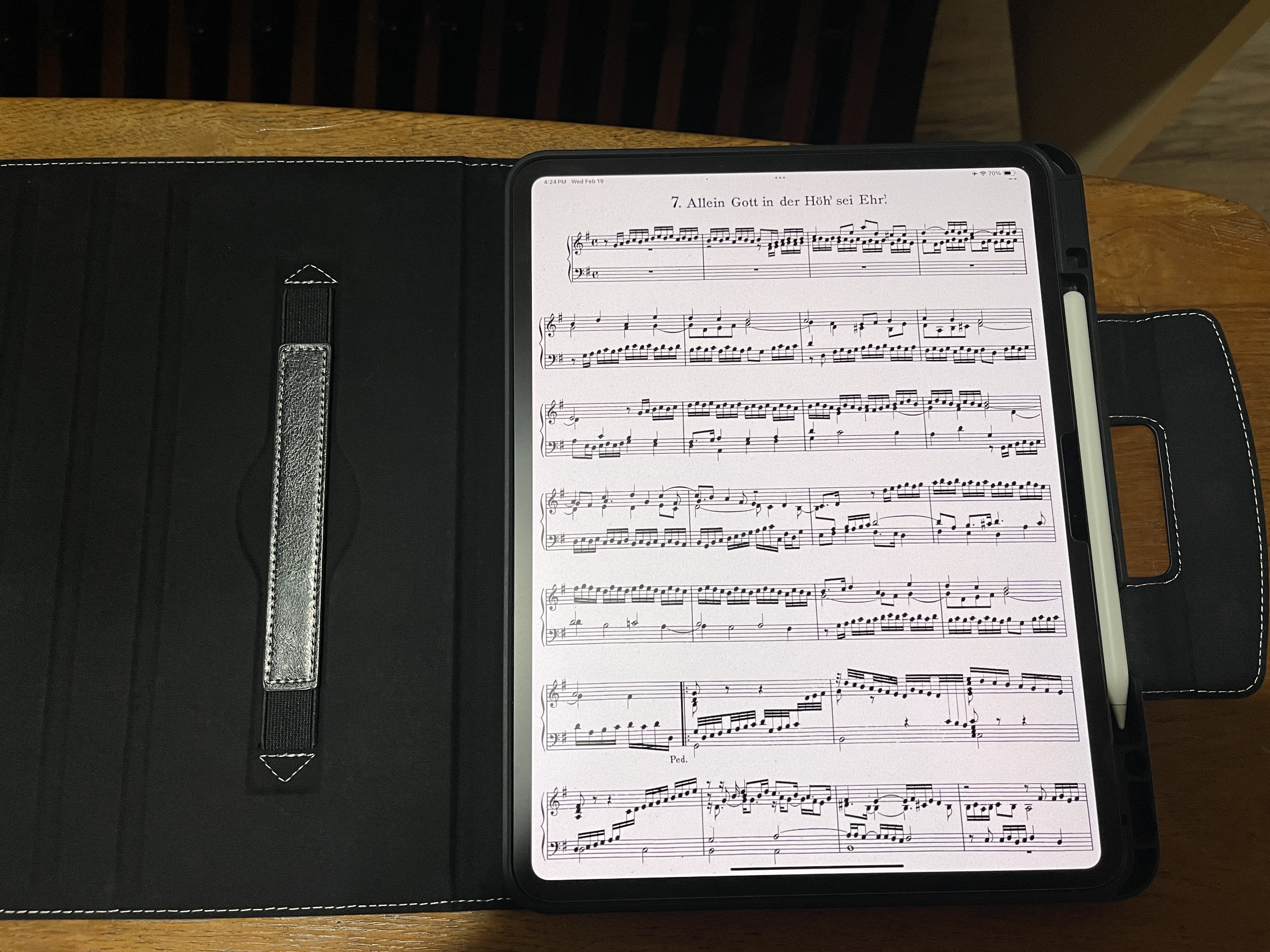For musicians who regularly read sheet music, switching to a digital setup can be a game changer. Whether you’re a pianist, organist, or play another instrument, the right tablet size can make all the difference in readability and performance. In this blog post, we’ll explore why the 13-inch iPad is the best option for reading sheet music and how it enhances a musician’s workflow.
Azure Hills Music contains affiliate links and is a member of the Amazon Services LLC Associates Program. As an Amazon Associate, we earn from qualifying purchases at no extra cost to you when you purchase using one of these Amazon links. Read our disclaimer and privacy policy for more information.
Why the 13-Inch iPad is Ideal for Musicians
Screen size is one of the most important factors when choosing a digital device for sheet music. Many musicians ask, “Is an iPad big enough for sheet music?” The answer largely depends on which model you’re using. Here’s why the 13 inch screen version of the iPad stands out:
- Legibility: At 13 inches, the display is nearly the same size as a standard printed sheet, reducing eye strain and making it easy to read complex passages.
- Full-Page Display: Unlike smaller iPads, the 13-inch iPad lets you see full pages without excessive zooming or scrolling, keeping your focus on the music.
- Ample Annotation Space: If you frequently mark up your scores, the extra screen space makes it easy to add fingerings, performance notes, and reminders using an Apple Pencil Pro.
Problems With Smaller Sized Tablets
When it comes to using iPads and tablets smaller than 13 inches for sheet music, several limitations can affect a musician’s experience.
One primary concern is the readability of dense music scores. On smaller screens, the notation can appear cramped, making it difficult for musicians to easily follow complex passages.
Additionally, the inability to view two pages side by side in landscape mode presents a significant constraint for those who rely on seeing the continuity between pages, such as during performance or practice. This limitation can interrupt the natural flow of playing, as musicians may have to frequently stop to turn pages, which is not ideal during a seamless musical piece.
As such, smaller tablets offer portability, but they may not provide the optimal experience for musicians looking to maintain smooth and uninterrupted performance.
The Benefits of a Digital Sheet Music Setup
Beyond size, using an iPad for sheet music offers a range of advantages that can improve efficiency and organization. With apps like forScore or Newzik, musicians can:
- Access a Vast Digital Library: Store and organize hundreds of scores in one device, eliminating the need for bulky binders. I travel to gigs with literally several thousand scores available at all times at my fingertips.
- Create Setlists and Bookmarks: Perfect for rehearsals, gigs, or church services, allowing quick access to music in order. My iPad has setlists for every liturgy of the church year for my church gigs. I also have dedicated set lists for my rock band and jazz combo gigs. No more carrying around hymnals, classical music folios, and sets of Real Books. Instead, everything I need for gigs and rehearsals resides on my iPad with no added weight for the thousands of pages I’ve digitized.
- Use Hands-Free Page Turns: With a Bluetooth pedal like the PageFlip Firefly or AirTurn, musicians can turn pages seamlessly without interrupting their performance.
- Adjust Display Preferences: Customize note size, brightness, or use dark mode for better visibility in different lighting conditions.
Essential Accessories for iPad Sheet Music Readers
To maximize the benefits of a 13-inch iPad for reading sheet music, consider these must-have accessories:
- Apple Pencil: The Apple Pencil Pro is ideal for quick annotations and score markings.
- Bluetooth Page Turner Pedal: Allows hands-free page turning for uninterrupted playing. I use the PageFlip Firefly, which works wonderfully with my iPad.
- Adjustable Stand or Mount: Ensures the iPad is positioned at an optimal viewing angle.
- Matte Screen Protector: Reduces glare under stage lights and offers a paper-like feel for writing.
Addressing Common Concerns
While the 13-inch iPad is a fantastic choice for reading sheet music, there are a few considerations to keep in mind:
- Battery Life: Although the iPad has solid battery performance, keeping a charger on hand for long sessions is recommended.
- Glare Issues: A matte screen protector helps reduce reflections, and proper positioning can also minimize glare.
- Initial Cost: While the price of a large and new iPad is an investment, digital sheet music can save money in the long run by reducing the need for printed copies. I source much of my classical music for free (other than the annual subscription fee) from the website IMSLP.
iPad Model Choices
In 2025, the iPad lineup offers several models catering to diverse needs, including the iPad Mini, iPad Air, iPad Pro, and the standard iPad. Each model presents unique features that can impact the experience of reading sheet music.
The iPad Mini, with its compact 8.3-inch display, is perfect for musicians who prefer a lightweight and portable device. However, its smaller screen may pose challenges for reading intricate musical scores, potentially necessitating more frequent page turns.
The iPad Air, sporting an 11-inch Liquid Retina display, strikes a balance between portability and screen real estate. Its vibrant display and support for Apple Pencil make annotating music sheets seamless, while the M2 chip ensures smooth performance for music apps.
For those seeking the ultimate in display size and performance, the iPad Pro is available in 11-inch and 13-inch models. The 13 inch version, with its Liquid Retina XDR display, offers unparalleled clarity and color accuracy, making it ideal for detailed sheet music. Its M4 chip delivers exceptional processing power, catering to professional musicians who require multitasking capabilities.
Lastly, the iPad 10th generation model, with a 10.9-inch display, offers a budget-friendly option without compromising on essential features. It supports the first-generation Apple Pencil, facilitating note-taking, though its display quality may not match that of the iPad Pro.
Overall, while the iPad Pro provides the best experience for reading sheet music due to its larger display and advanced features, the iPad Air and standard iPad offer excellent alternatives for those prioritizing portability or affordability.
iPad Memory Considerations
The 13-inch iPad offers a range of memory options, typically starting from 256GB and going up to 2TB.
For musicians, choosing the right amount of memory largely depends on their specific needs and how they plan to use the device. For instance, if a musician primarily uses their iPad for sheet music apps and some light recording, 256GB might be sufficient.
However, for those who intend to use more storage-intensive applications like Logic Pro and Final Cut Pro, along with maintaining a large library of music samples and video projects, opting for 1TB or even 2TB could provide the necessary flexibility and capacity.
I chose the 1TB version to ensure that I could seamlessly run Logic Pro and Final Cut Pro, along with my sheet music apps, without worrying about storage limitations. This allows me to work on complex projects and have ample space for future needs.
Final Thoughts
For musicians looking for a reliable, full-page digital sheet music solution, the 13-inch iPad is the ideal choice. Its large screen size and powerful apps and accessories make reading and managing sheet music easier than ever. I made this investment several months ago by upgrading from my prior 9.7-inch iPad. I’ve been more than pleased with the improved experience using the larger size iPad for reading sheet music.
I hope you found this guide helpful. Thanks for stopping by to read this article.
Happy music making!
Arthur Dobrucki


